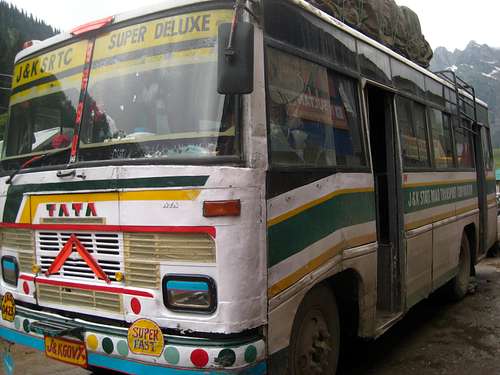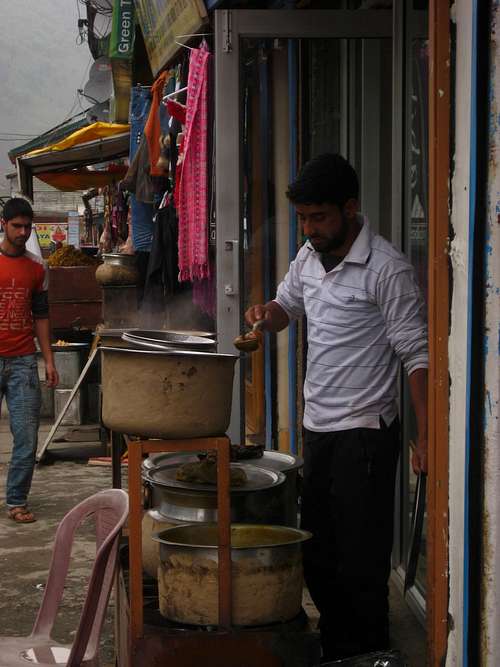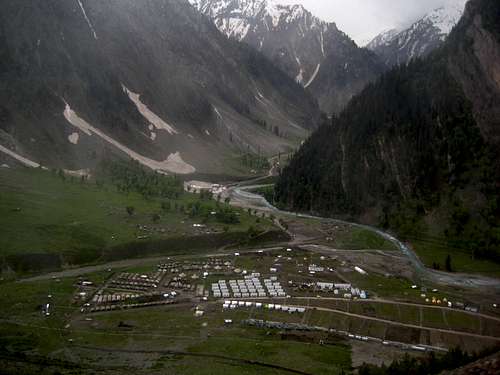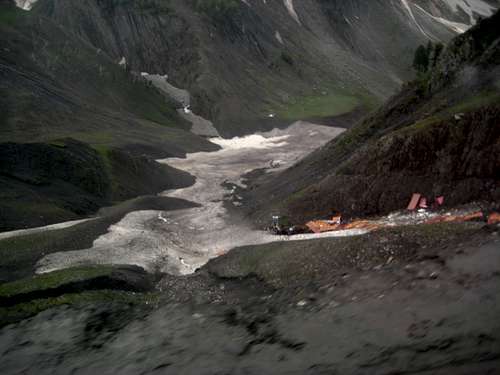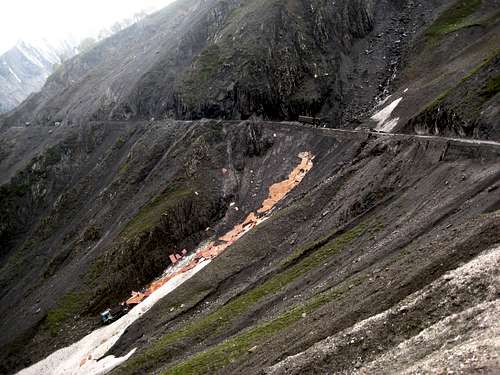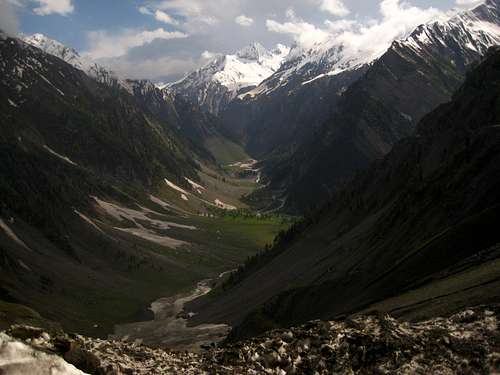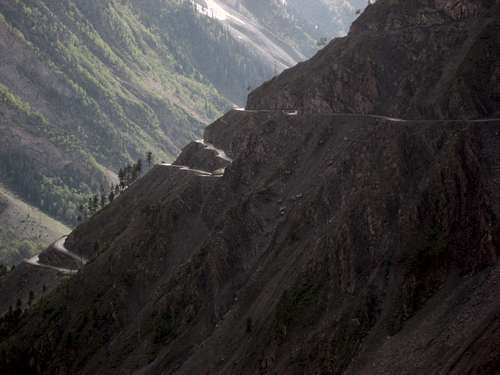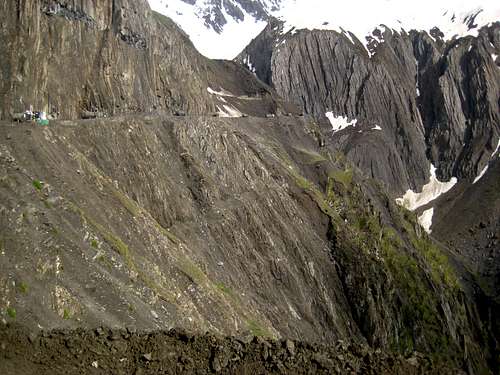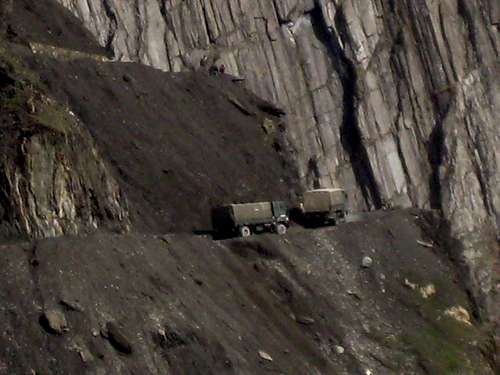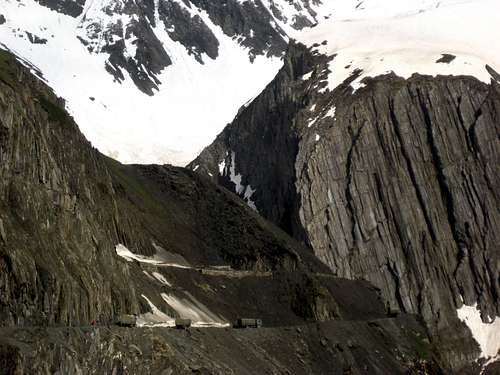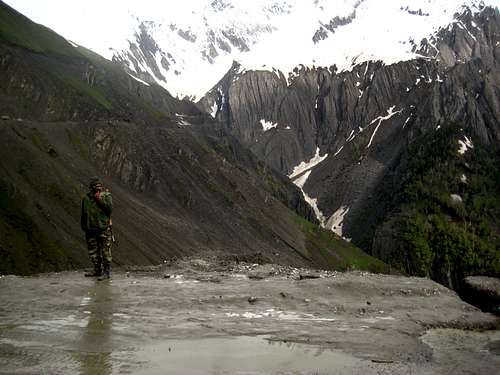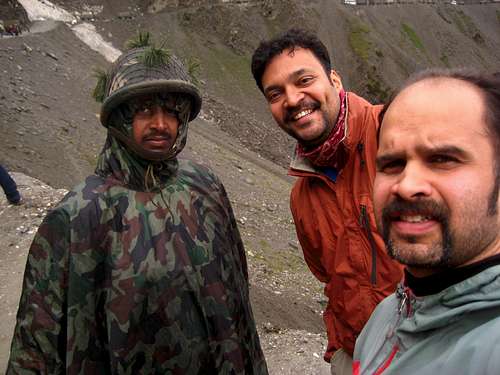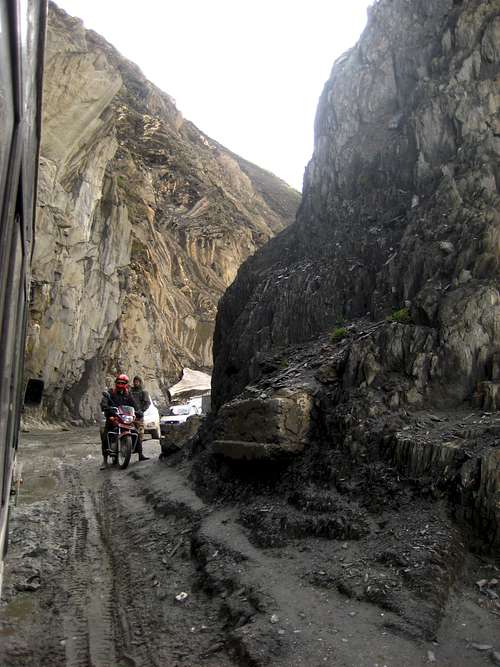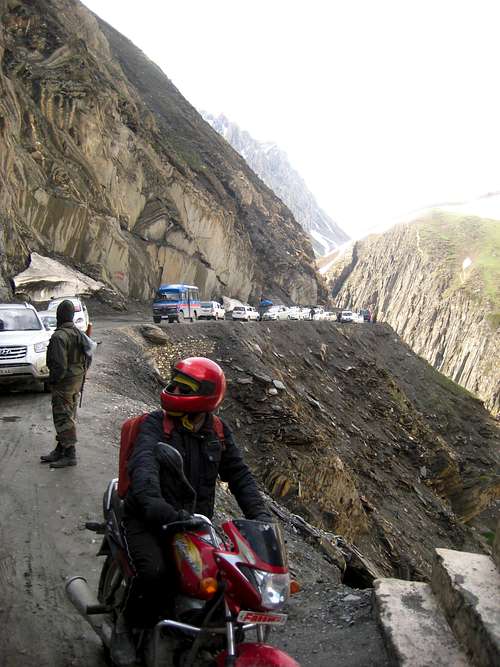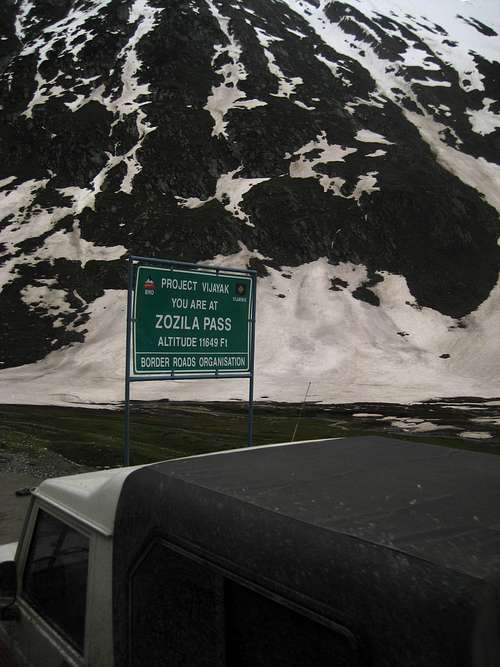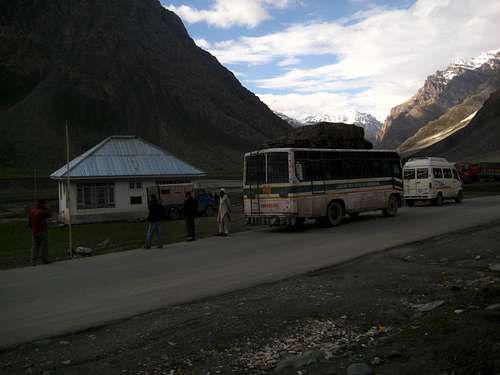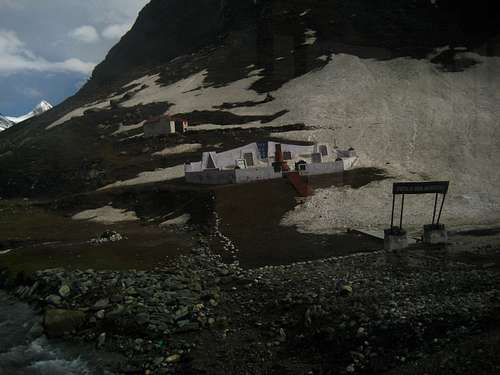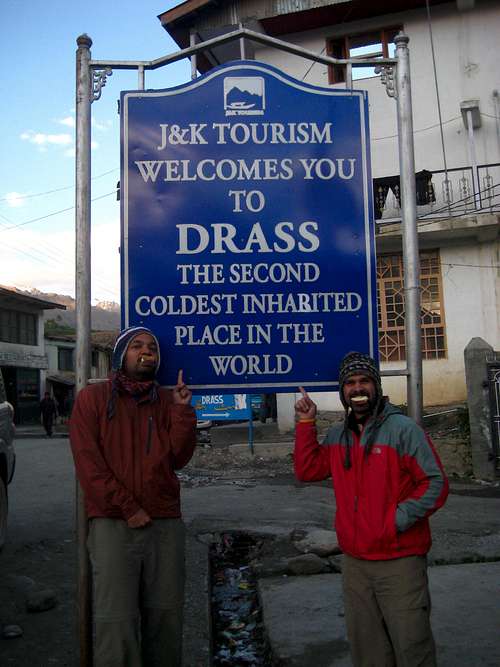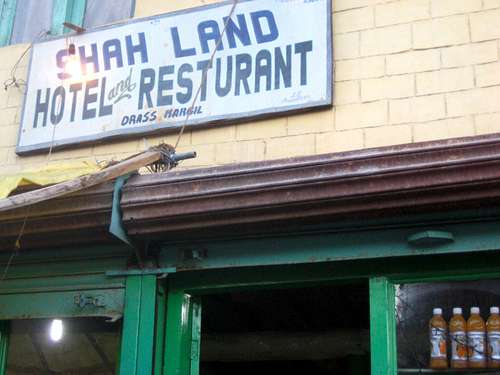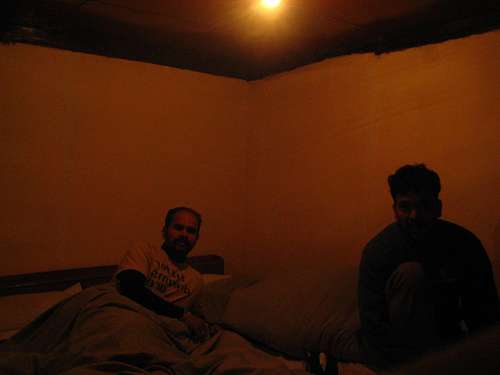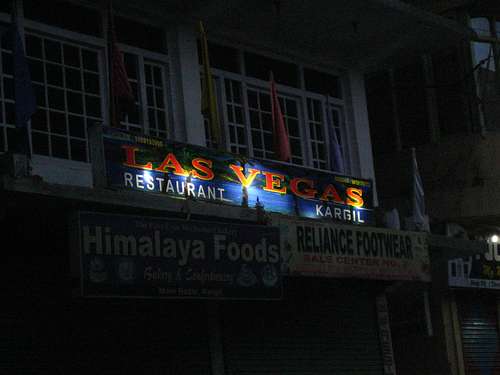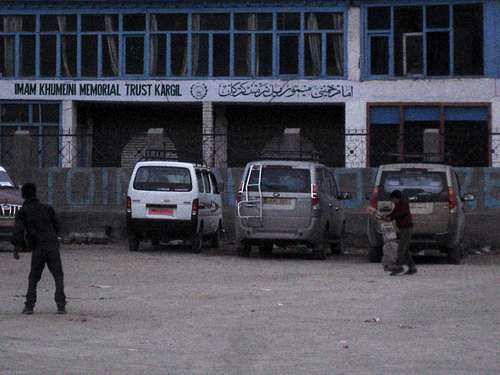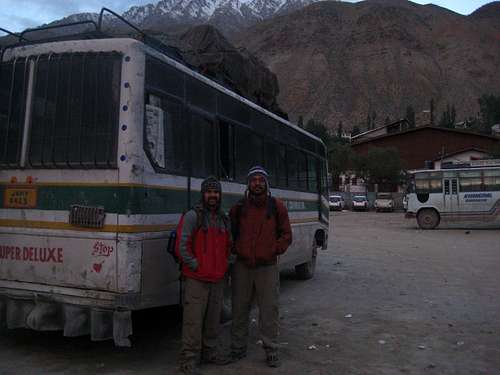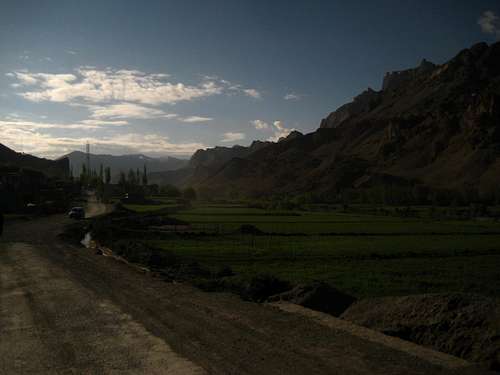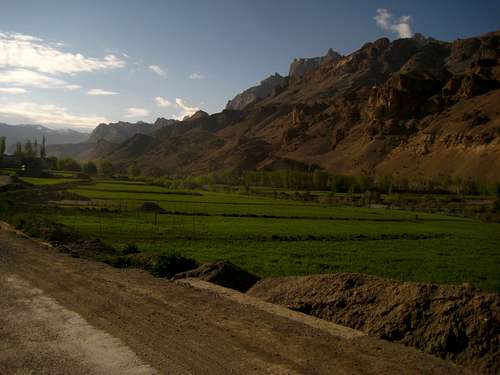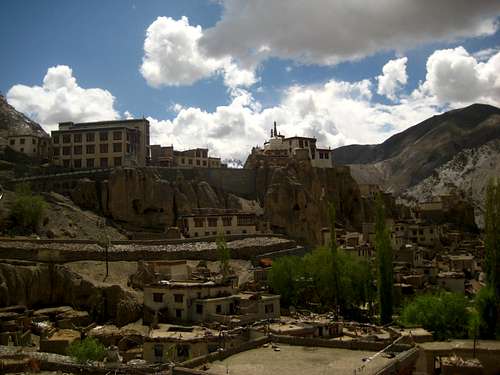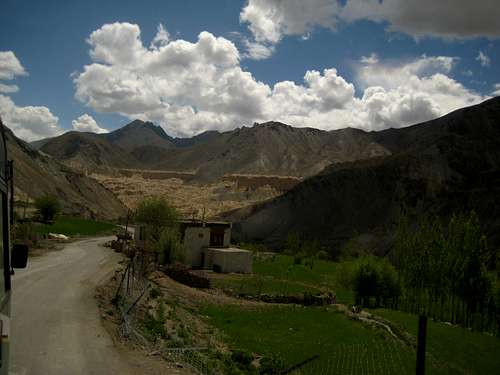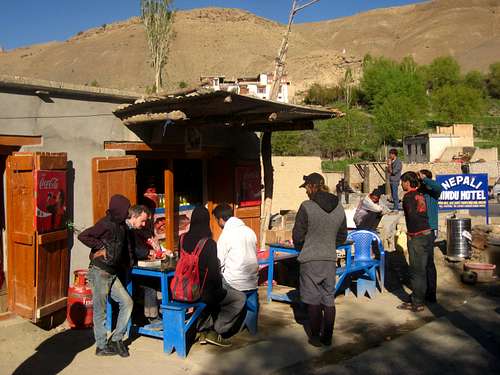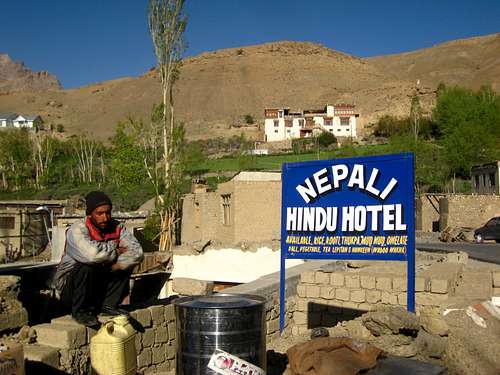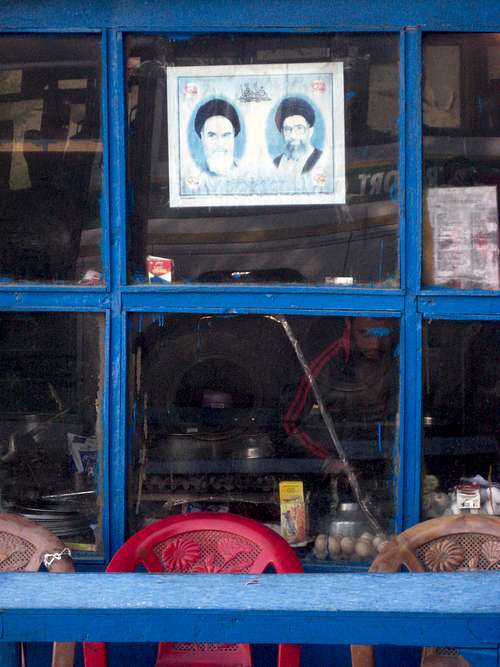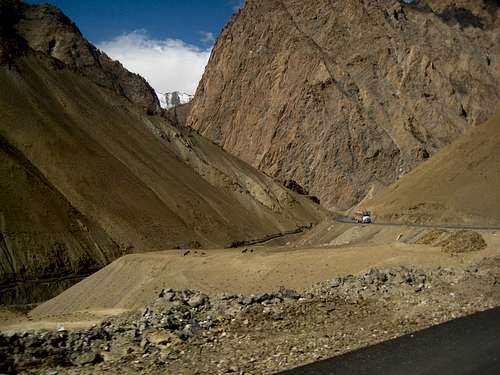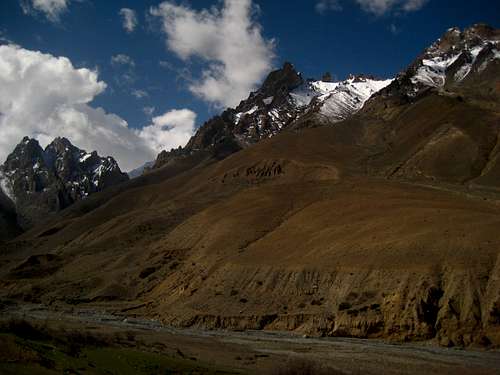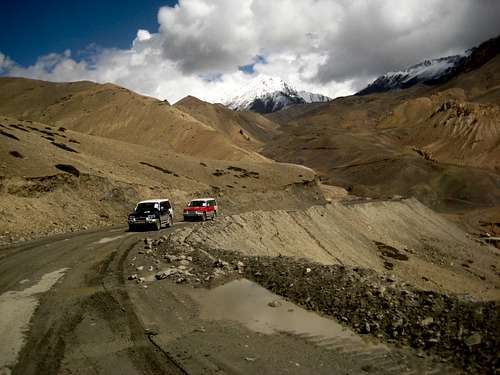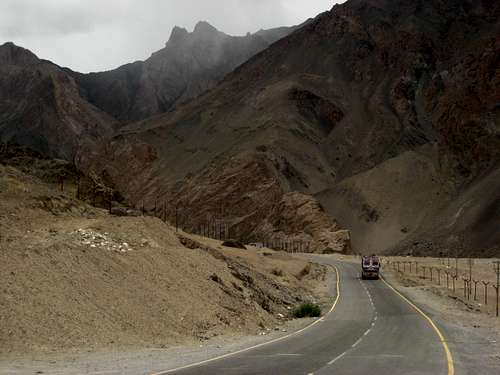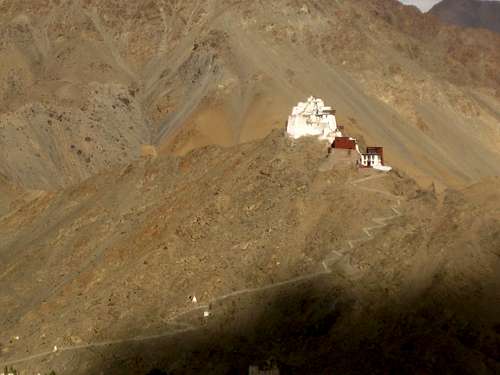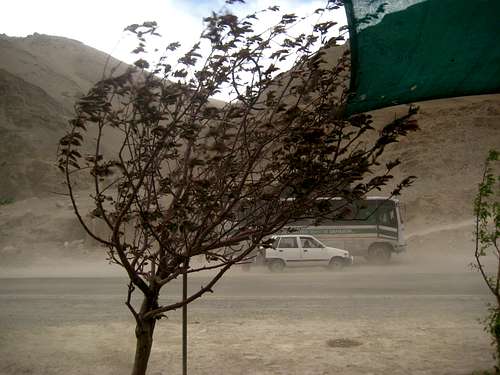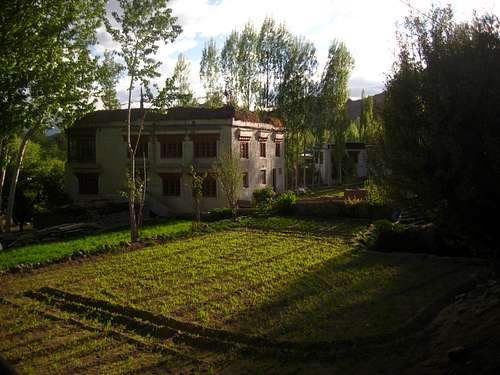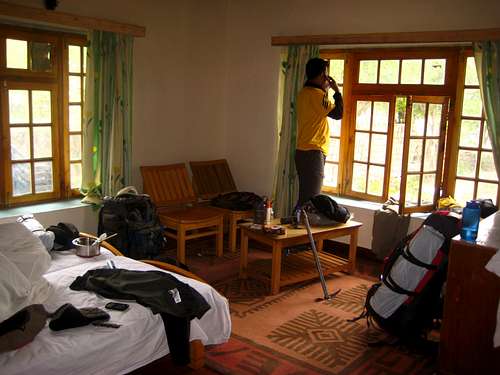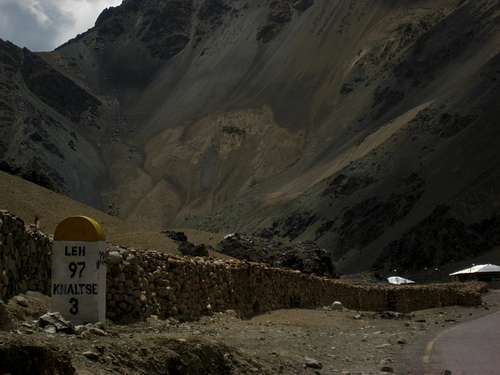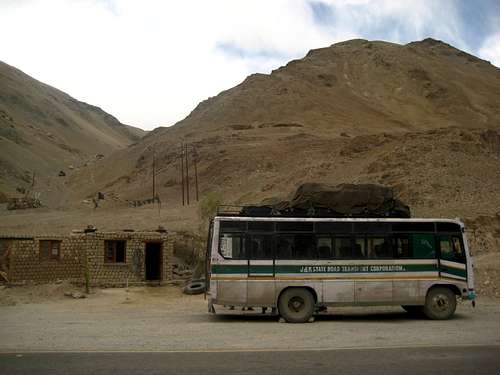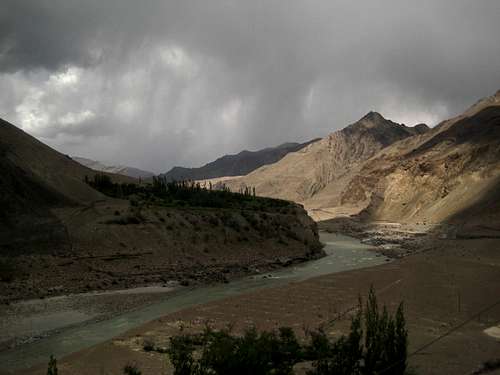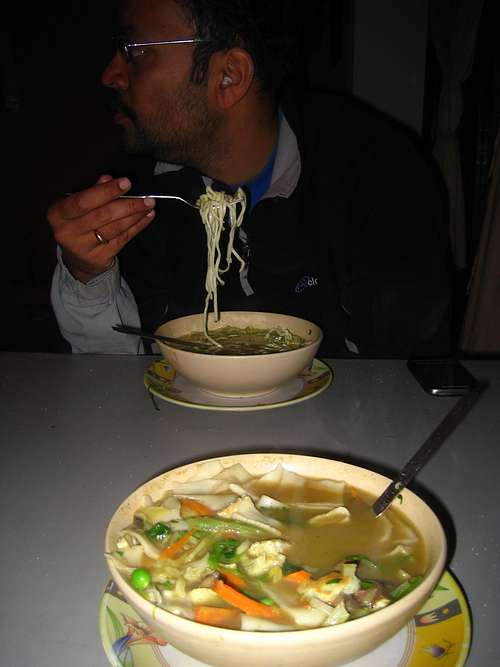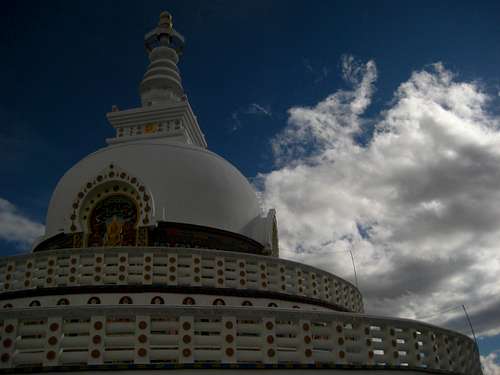|
|
Trip Report |
|---|---|
|
|
Jun 9, 2012 |
|
|
Mountaineering |
Deluxe Bus
***
I and my buddy, Om went on a climbing trip to Stok Kangri, in Leh area, J&K, India. This trip report is on the journey from Sonamarg to Leh, which was one of the most eventful journey for both of us!
***
The bus will be a deluxe one – said a very confident Mr. Qureshi, the JKTDC (Jammu Kashmir Tourism Development Corporation) officer-in-charge, when we paid him an amount for reserving two seats for us from Srinagar to Leh, although we were boarding the bus in Sonamarg.
He certainly took his commission, but we had no reason to complain, as we were getting our reservations done, without thinking too much or putting in too much of effort. Our original plan for the Sonamarg – Leh travel was to just hop-in on any transport that we could get our hands on. It’s only at Sonamarg that we realized that hopping on onto a jeep; bus etc. was not an option, as we had fewer days at hand. The local JKRTC (Jammu and Kashmir Road Transport Corporation) guy we were pursuing since last 2 hours finally showed up, and told us – this is your bus. A bus which was supposed to come at 10:30 am, arrived at about 2:30. We were relieved, that it came. An entry in the “deluxe” bus made us land directly onto a couple of backpacks, which were pretty much everywhere in the rear of the bus. We looked around – a couple of foreigners were sitting, tired from the journey from Srinagar to Sonamarg. A lady who was cuddled up in a blanket, reading a book gave us a “sit wherever you see a space” look, told us she was tired with the last leg of the journey. She turned out to be a great company, and we made good friends with her. We were told that the tire got punctured twice while on the way up. One thing was for sure – we were up for an interesting and eventful journey towards Leh.The journey from Sonamarg to Leh consists of crossing a steep and crucial pass, called Zozila (la in local terminology means pass).
The pass is at about 13,500 ft of elevation, which is not too high for a Himalayan pass, but the road towards it is strewn with difficulties – hairpin bends, a 4000 ft fall-off on one side, and muddy / slushy debris on the road, which is not tarred. Hence, the bus driver has to be an “accomplished” one, with experience to tackle such conditions. We were told that the driver is a “senior” one. Because the bus was going to endure such gruelling conditions, a good check-up of the bus was done at the stop in Sonamarg. Luckily, when the helper slid below the front end of the bus, a loose nut and bolt were found, which was tightened. Had the screw given away on the path ahead meant – everybody in the bus got screwed!Finally, at around 3 pm, we embarked on a journey, which was going to be one of the most eventful journeys of my lifetime.
Leaving Sonamarg behind, we passed the High Altitude Warfare School, which is the training ground for the Indian Army, for its people to acquire skills for high altitude combat. A few km ahead, westarted seeing the left-over ice and snow on the banks of the river which flowed right beside the road. And, in those cold conditions, we saw a bunch of guys river-rafting! What a stupid people, we thought – if anyone falls in the river, he /she is surely going to die of hypothermia. Although it was summer, this was certainly no time for rafting down the river.
A few years ago, Om had come up this route, to go to Amarnath, the sacred Lord Shiva shrine, nestled in the higher Himalayan heights, at around 16,500 ft. This
route is also the one on which maximum people die of HAPE or HACE, due to the sudden height gain and back within a span of two days. It is mandatory for the pilgrims to do this in two days, and nobody is allowed to camp / stay at any other place other than the designated campsite, due to the sensitivity of the area. It can be accessed via two routes – through Sonamarg to Baltal as well as through Pahalgam. Quite a few people prefer Baltal, where a massive campsite is erected by the Indian Army, with cooperation from the central as well as the J&K government. Our bus passed the bifurcation, which takes one to Baltal, and the other route goes to Zozila.
Scary Zozila!
As we climbed up towards Zozila, we could get a better view of the campsite, and the valley through which the trek route goes up. The valley was a beautiful one,
with snow-clad peaks in the background, and green pastures along their slopes.
of J&K, in these mountainous regions, it’s all scree. This means if you pour one bucket of water on a hill-slope, 3 buckets of mud washes down, and the road gets completely mud-washed, which makes the tires of vehicles slip. Our bus driver was a “senior” one in his group. It is said that this route is not given to the faint-hearted and new amateur drivers. All our lives were in the hands of this “senior and experienced” driver.
As the hairpin bends started and our bus started gaining elevation, I realized the “drop-off” we had on one side of the mountain. Now, I am a frequent visitor to the Himalayas, and I was used to travelling on such roads, but this was a completely different animal! I was on the window-seat, and I could see the tires trying hard to get a grip on the mushy road below. There were multiple turns where there was no chance for an error. Had the driver taken a larger / shorter radius for the turn, there was just no way for him to retract his route back a few feet, and go further again. The only way was down. The climb was a treacherous one, one which literally
gave me goose bumps.
The wobbling of the bus was so much that I wondered if our packs on the roof were getting dislodged, and getting thrown down – one by one. Suddenly I tried to remember if the conductor had tied the packs properly or not. I wished he had. I was clutching on to the luggage area above the seats, as if that is going to save my life, if the bus “ever” topples into the valley to the right. One truck had gone down a couple of days ago, and its remains were visible about a thousand feet below the road, and it was ugly. I heard both the driver and his helper died as they were thrown out of the windshield. Om was trying to sleep; he had a headache. He was drinking water to get it down. With me all scared to death, here were a few other nationality people who were riding the bus with us, and this is what they were doing:
- Two Brits – the couple – was sleeping peacefully, as if they were in a hotel room.
- One Tasmanian dude – Daniel – was reading a book. We asked him if he had packs on the top of the bus. No – was his reply. We realized that he had just one small pack near his feet. Out of this pack, he took out a giant SLR, which must have taken half of his space. I guess, with the SLR, the book, he just had another change of clothes, similar to what he had worn. Black slacks, a short on that, a T-shirt, and a cap. That’s it. In Leh, when we saw him about 3 times, he was dressed the same. He completely re-defined “minimalism”, according to me and Om.
- A German girl, who was listening to something on her phone / mp3 device.
- A Greek guy, who was admiring the scene outside.
- A South Korean girl, who was reading a book.
The bus came to a halt.
A peep outside the window, and I see two JCB (earth excavating machine) on the higher slopes in front of me. They are actually huge machines, but compared to the scale of the mountains, they looked tiny. And, behind one of them was a long queue of cars, which ended at our bus. Traffic jam, we correctly guessed, and got down. There were a couple of Indian Army soldiers standing, chatting with each other. They told us that the pass was unreachable, as a lot of scree had come down the slopes, and the road was completely washed out. It has snowed the earlier day, and the snow and rain was responsible for this. How much time would we be stuck – nobody knew. So, we spent the time munching on biscuits, and little bit of the Aloo Paratha we had packed up at Sonamarg (we had lunch on these parathas there). One after another, Army 6-tonners started lining up behind our bus. And, after about an hour, all we could see were these olive green vehicles all lined up behind us, some 80 or 100 of these.The pass opened up after about 2 hours, and as the protocol of this region allows - the Army convoy was allowed to pass before any civilian vehicle. This convoy was carrying supplies to the entire establishment of Army in the Leh region, for the coming winter. Once winter sets in, the Ladakh region gets cut-off from India, as there are only two routes. Manali – Leh, via Rohtang La (pass), and Sonamarg – Leh, via Zozi-la. It is said that Zozila is purposely kept accessible even duringwinters, as it allows minimal communication of the two regions. The brown rock face, olive green 6 tonners slowly moving on the road, as if in a Marching session, looking like ants, and the valley below – it all looked pretty dangerous, at and the same time beautiful. Another half an hour later, our bus moved. We were glad that we were at least going to cross Zozila before sunset. I couldn’t imagine a journey on this kind of road at night. Well, in one way – it could be easier, as nothing is visible in the valley below; it just is one giant abyss of darkness.
The actual place where we cross the high range are actually very vividly carved out rock faces. These two faces / pillars, along with the road through it (which is cobbled), is called India Gate. The army soldiers had comforted me by saying that the gradient of the slopes after Zozila reduces, and one need not worry about the fear of a vehicle going down. I was relieved to see the gentler slopes as soon as we crossed India Gate. In a pretty childish and stupid way, I was assessing the
slopes and telling myself – even if the bus falls down here, I would be seriously hurt, but I won’t die!
Within about half an hours’ ride, our bus halted at a post where all the international visitors had to register themselves, by showing their passports. This was something that they had to do a couple of times in this journey, which annoyed them a lot. But, rules are rules, and I am sure it is on some experience that the government had made these rules. We later realized how important this was, when an American hiker joined us from in the middle of nowhere. She was in a complete despair, when she got lost; her fellow hiker friends had gone someplace else, and she was left alone in the mountains. She had drifted across, and was finally escorted by the Army people to our bus. She was so relieved to have come back amongst humans again.
The bus whizzed past the Zozila war memorial, a memorial of national importance to India. In the year 1999, when Pakistani armed forces attacked the Indian side, it led to a full-fledged war called Kargil war. It started with infiltrators dresses as terrorists, who wanted to cut-off this highway to Leh, so that they could capture the entire area. When the terrorists were killed and Pakistani uniforms and IDs were recovered, it was learnt that they had captured higher points in the area. This even led to the making of a movie called “Lakshya”, which was a good hit in India. Given a chance, I would have loved to spend some time at the memorial, and would have loved to pay my deep respect for the Indian Army officers and soldiers who laid down their lives in that war, so that we could rest peacefully in our homes. Unfortunately, the driver’s utmost disregard for this (he must have gone past this hundreds of times) was surprising as well as understandable.Kargil
The bus had intended to stop at
Kargil for the night halt. Kargil was a good couple of hundred kilometres away, so we had no ideas as to when we will reach Kargil, where will we stay, and when we will reach Leh the next day. When we asked the driver, he told us that we would be stopping at Drass, a place which holds the distinction of second coldest inhabited place in the world. It is said that the first one is somewhere in Russia. The bus took a break at a local tea shop, where I and Om had 2 glasses of tea each, with 2 slices of cake to go with it. The Brits went further inside the shop, to find out what the guy was serving for lunch. He hasthe usual roti and sabji (curry). Considering the hygiene of the place (a normal Indian traveller would have eaten there), we were surprised to see them eat there. The Tasmanian guy and the German girl also joined them.
When we were boarding the bus, we had a chat with the Brits. They were a pretty interesting couple. They had stable jobs, a home they had bought, cars, bank accounts – everything that a “normal” guy or girl has, once he / she starts working. One fine day, which was about 3 years ago, they decided to go for a world tour, and they sold off everything. They embarked on their journey and had visited more than a 100 countries. The way they travel was to couchsurf, a popular way to stay with the local people in a town, and return the favour when somebody visits them in their country. Couchsurfing is a very popular way to see places, without
spending on the hotels.
we forgot it. He was on the verge of completing his journey around the world in a green manner, and either National Geographic or Discovery was following him. It
was such an amazing story and such an amazing feat that this guy was trying to achieve, that I and Om almost instantly wanted to meet him, and congratulate him on the challenge he had taken up. The conversations with the Brits ranged from the football league (Om knew quite a bit about this, because of his stint in the UK), India, its culture, and what they thought about Indian people in general. They ridiculed discrimination which still goes on in some parts of Europe, and were (interestingly) amused with one aspect of Indian tourists in general – they said, “Indian tourists rarely look at the menu, assess the cost of things, and order accordingly. They always eat what they want, and in the end, ask for the bill. How come Indians, who in general are pretty cost conscious, are ironically opposite while travelling?” I told them that this habit had a cultural connection. In their daily lives as well as regular routine, they try to save every penny possible, and live in a thrifty manner. This way, when they set out for a trip, they become utmost spendthrifts, and don’t think too much about the amount they are spending. The conversations lightened up, when we passed through terrains of such variety. At times, we had ultra-green patches with a few homes making up a village. This was almost always near the river we had been following since we crossed Zozila. And, as soon as the village passed by, we encountered moon-surface-like terrain, which was pretty amazing. All of a sudden, on the right hand side, we could see tall mountains, snow-clad, with a single cloud hovering over its summit. I had known
that the twin peaks Nun-Kun were somewhere in this area. These are massive 7000 m peaks, which I don’t know if I spotted or not, but I may just have. Then, all
of a sudden, you see a very colourful truck coming your way, and this truck added so much of beauty to the otherwise arid region.The sun finally set on our journey for the day. This was followed by a real test for our patience. Kargil was more than a 100 km away, and with everybody extremely tired, we just wished that god would swirl a wand which would pick up our bus and land it in Kargil. Unfortunately, there was no wand, and no pick up and drop. So, we waited. Whenever we saw small flickering lights in a distance, somebody would shout in excitement – Kargil is here. Sadly, we passed about 8 of such small hutments / villages (Kharbu, Kakshar etc). Our bus, which was destined to reach Kargil at about 6 or 7 pm, reached Kargil at around 10:30 pm. At 10:30, we were in a desolate bus stand of Kargil. No place to stay, no place to eat, nowhere to go. Mr. Qureshi had given us a letter on his letterpad through which he had requested the local JKTDC office people in Kargil to offer us a place to crash for the night. This place was usually reserved for the officers, but Mr. Qureshi thought his letter might help us out. But, there was no way in this world that we were going to find anybody at this time. The letter didn’t get used, and we were roaming the streets of Kargil, looking for a place to stay, and eat. As we were thinking about what exactly to do, 2 small kids run up to us and ask us – “Sleep? Sleep?” They thought, like our foreign friends, we were also non-Indians. Our reply in Hindi surprised them, and mutually we agreed to go and check out a place, where we could crash for INR 100 only. The place turned out to be a big hall with mattresses strewn all over, and rats running around in the hall. We were not ready to spend the next 5 hours of sleep by paying an exorbitant amount, but we certainly were not up for hall with rats running around. A dinner of Rajma-Chawal in Hotel Las Vegas (in Kargil), we decided to spend the night in a room we got for INR 800. I ran to the only open STD/ISD booth, called up my folks to tell them that we were fine. Om’s home phone was not getting answered, so told my folks to intimate them.
4.5 hours later, our alarms rang. Without any tea or coffee, we did our morning chores, and started walking to the bus stand. As decided, we were greeted by one of the fellow passengers on the bus stand. When asked about their place of stay, David and Cathy (Brits) told us that they stayed the night at a place which charged them 50/- per night. We wondered what this place would be like, which was half the price of a place we declined!
Experiences
The journey resumed, and as we passed Lamayaaru,
a French lady got onto the bus. She had been staying at Lamayaaru for the past 1 week, and had soaked up all the culture that the place had to offer. The monastery itself was set in a beautiful place, with majestic mountains rising behind it, and patches of green in the front, besides which a river flowed. The lady couldn’t speak any English, but was trying to explain everything that she did and she felt while she stayed there. She indeed had a nice time, and she went on to explain the festival that is going to take place at the monastery, in the coming week. This got all the foreigners excited, andthey started planning out their trips back to this region.
A few hours later, the driver halted at the “second coldest inhabited place” on earth – Drass. This is where the temperatures go down to -60 deg C, and people still stay in their homes, without the luxuries of heated homes or fireplaces, things usually witnessed in the west. I and Om got down to have a quick chai, along with which we had single slice cakes. The foreigners inquired about the breakfast that was available there – 2 parathas and subji, for 40/-. The Brits got excited, and jumped at the offer, as they were sure they were not going to get anything this cheap later in the journey.
The Tasmanian dude also jumped in, and they had a good mini-meal. A few clicks of the nearby environs, and we were on our way out towards Leh. We hadn’t gone far, when our bus broke down, with another tire that had gotten punctured. This was near a village, so we got help immediately from the local villagers. While the tire was getting replaced, I and Om had some time to interact with the people from outside India. The German girl said that she was on a 8-month tour of India. She had been to places like Rajasthan and Gujarat, and found them very colourful and interesting. She was completely awed about the vibrancy of these two states, and after having visited Amritsar, she had roamed around in J&K. The next leg of her journey was to explore Leh, and then move on, again via a local bus – to Manali, via the Leh – Manali highway, which is supposed to be a very pretty route.The Greek guy told us that he had married a girl from Bangladesh, and he was very well aware of the culture as well as cuisine of India. To our amazement, he even managed to flawlessly speak a few sentences of Hindi – enough to get around. We were shocked to find out that the South Korean girl couldn’t even speak a single sentence of English, and yet – was travelling in India for the past 4 month or so. She started with visiting West Bengal, had travelled to Orissa, been to Kanyakumari, and after a visit to Mumbai, had started coming up North, via Punjab, Delhi to J&K and now to Leh.
She had planned another 6 months, in which she was going to explore Ladakh, then move to western India, as the summer faded away. The Tasmanian guy – Daniel, had no plans. He told us – wherever I like, I will stick around for some time, and whichever place I feel like visiting – I will leave for that place. The dude had come from Nepal, after having summitted a 19-thousander, along with a couple of his buddies. The buddies returned back to their homes, while this wanderer decided to stick around in India.While the tire was getting changed, we had a quick chai (tea) at a place, which also served Aaloo Parathas. Dave and Cathy asked the price of the parathas, and got back a 20/- figure. Cathy asked if she wanted to add “Haree Mirch” (green chilli) to the parathas, how much it would cost. The lady responded with a 28/-. Shocked at the elevated price, she told the lady the price of a kg of chilli in India (which even I wasn’t aware of), and how could she charge 8/- to just add a few cut chillies.
The owner of the shop was amazed at the depth with which Cathy was asking for explanations. Finally, Cathy and Dave decided to walk a little further, and had tea over there. And, they managed to save around 6/- on the tea, cumulatively. This made me realize the fact which Cathy would tell me later on – that a usual Indian tourist would have a full meal and everything that goes with it, without asking much about the prices. This was indeed true to a large extent. After the quick chai and parathas, all of us paid visit to the toilets that were made for tourists. It was a make-shift arrangement, where a big hole is dug, with two planks for you to stand / sit on. Only thing was it had privacy – it had 4 walls and a door to keep you away from the gaze of the strangers outside. This was very similar to the toilet I had used on the second camp of Mt. Rainier, and similar toilets are a part of daily lives for people living in rural areas in India. The stench of the air inside the toilets wasenough to suffocate anybody to death! Luckily, we all survived.
The tire got replaced and we realized that we had wasted about an hour and a half in this whole exercise. The bus got started, and after meandering through unbelievably beautiful vistas, it took a halt for lunch – at a village called Khaltsi. The hotel which served food was a regular dhaba, which had fixed-menu food to serve. Whatever he had prepared that morning was kept in big pots, and he only gave two choices – roti or rice. Because of not having had breakfast in the morning at Drass, we had a hearty meal at that dhaba. Tired from the almost 20 hour journey, everybody fell asleep, only to be woken up by a sudden jerk! Everybody woke up – and saw that we were on the road, and 2 Army guys were blocking our way. Our bus was taken to the side of the road, and the driver was told that we are supposed to take somebody along with us to Leh. Wondering who needs a lift in this “middle-of-nowhere”, suddenly everybody’s eyes focused on 2 more Army soldiers walking down from the adjacent mountain, and in between them was a blonde. Now, this was a place where you would not find a tourist, as there was no village nearby, no contact with locals, no dhabas, no restaurants – nothing! So, where was she coming from – everybody had a question on their minds.
Adding to the French, German, Greek, South Korean, British and Tasmanian nationalities in our bus, we now got an American! The new tourist was a hiker from California, and along with a couple of her friends, had taken a completely off-beaten trail to hike on. Somewhere in the middle of the trail, she got separated from the friends, and got lost. She tried finding them, but couldn’t. I and Om wondered as to how friends can separate out in such terrains, when there is a dire need to stay together. One should NEVER leave anybody behind, and here she was - a classic example of a lost hiker in the mountains of Ladakh! When she boarded the bus, she was almost in tears, as she had been trying to search for her friends for the last 1 hour or so, and had been unsuccessful. Then, she saw an Army post, where she produced her passport and they walked her to the road, where she ended up in our bus. Instant conversations of “who is from where, and who is going to do what” began, and it was amazing to see such diversity in nationalities, and hence in opinion.
Since the bus had left Srinagar, it had a flat tire 3 times, two before we boarded, and 1 just before lunch. Everybody was frustrated when we had another one, and this was in the middle of nowhere, so everybody wondered how it is going to get fixed. This was a place which reminded me of a scene from the movie – Jab Tak Hain Jaan, featuring the Indian superstar, ShahRukh Khan, in Army coveralls, donning a Ray Ban, riding a Olive Green Royal Enfield in similar terrain. We all got down to see that there was nothing for miles together, but a dhaaba right opposite to the place where the bus broke down. Nobody quite understood the relevance of having a dhaaba at such a location, but I guess – the owner must’ve thought before opening up shop. Guess, it was for people like us – journeying in dilapidated buses, which can break down pretty much any time. Also, when we looked at the skies, it had started getting dark. Not because the sun was going down, but a huge sandstorm was coming in! Some people just wandered in the nearby mountains, while most of the people ran inside the dhaaba. I and Om went in and saw the South Korean girl sitting by herself, taking down notes. She had ordered a plate of Maggi, and was eagerly awaiting it. We got into a conversation with her, and she mentioned that she can survive on Maggi for a few months, if nothing else is available anywhere she travels. She loved the variety of fish that was available in Kolkata, she relished the Dosa in Chennai, and was amazed at the French cuisine that was available in Pondicherry! The notes that she was taking down was hertravelogue, and she was writing in her local dialect of Korean. I and Om thought – here is a classic example of things that a human can do in a foreign land, with only one prerequisite – attitude. She could hardly put together 2 – 3 words in English together, had never been out of South Korea, was studying commerce, and had taken the giant leap of travelling in a foreign land – that too – alone by herself, for 8 months! Awesome was the word for her.The sand storm that was brewing outside lasted for about 20 minutes, in the middle of which we could not even see the bus on the other side of the road. Sand and dust was moving at such high speeds that if you run through it – it felt as if arrows were piercing through your body. The storm had not ended, and we saw the driver waving his hand to us, shouting something which we could not decipher. We took it as a signal that the tire had been fixed, and we could board the bus. The
South Korean girl finished up her Maggi in a hurried manner, tucked away her notebook and pen, and ran along with us to the bus. It was almost 2:30 pm, and after having spent a day in this bus – taking in these wonderful experiences, we all were eager to reach our destination as soon as we could. The road ahead was not dangerous, and we could see some really beautiful and picturesque locations, with villages nested – sometimes on cliff-tops, sometime in the valleys. We would pass by occasional local monasteries and local kids would wave to us with their smile, and their red-cheeks would shine in the sun.About 26 hours later, it was around 4:30 pm, when we reached Leh. Everybody was tired, but managed to climb to the top of the bus to throw down the backpacks. Greetings were exchanged, and everybody dispersed to pursue their plans forward. As planned, we took a taxi to Changspa road, where we had arranged for a homestay.
After having travelled for many years now, I can easily say that I have never ever undertaken a journey as interesting and eventful as this one.


